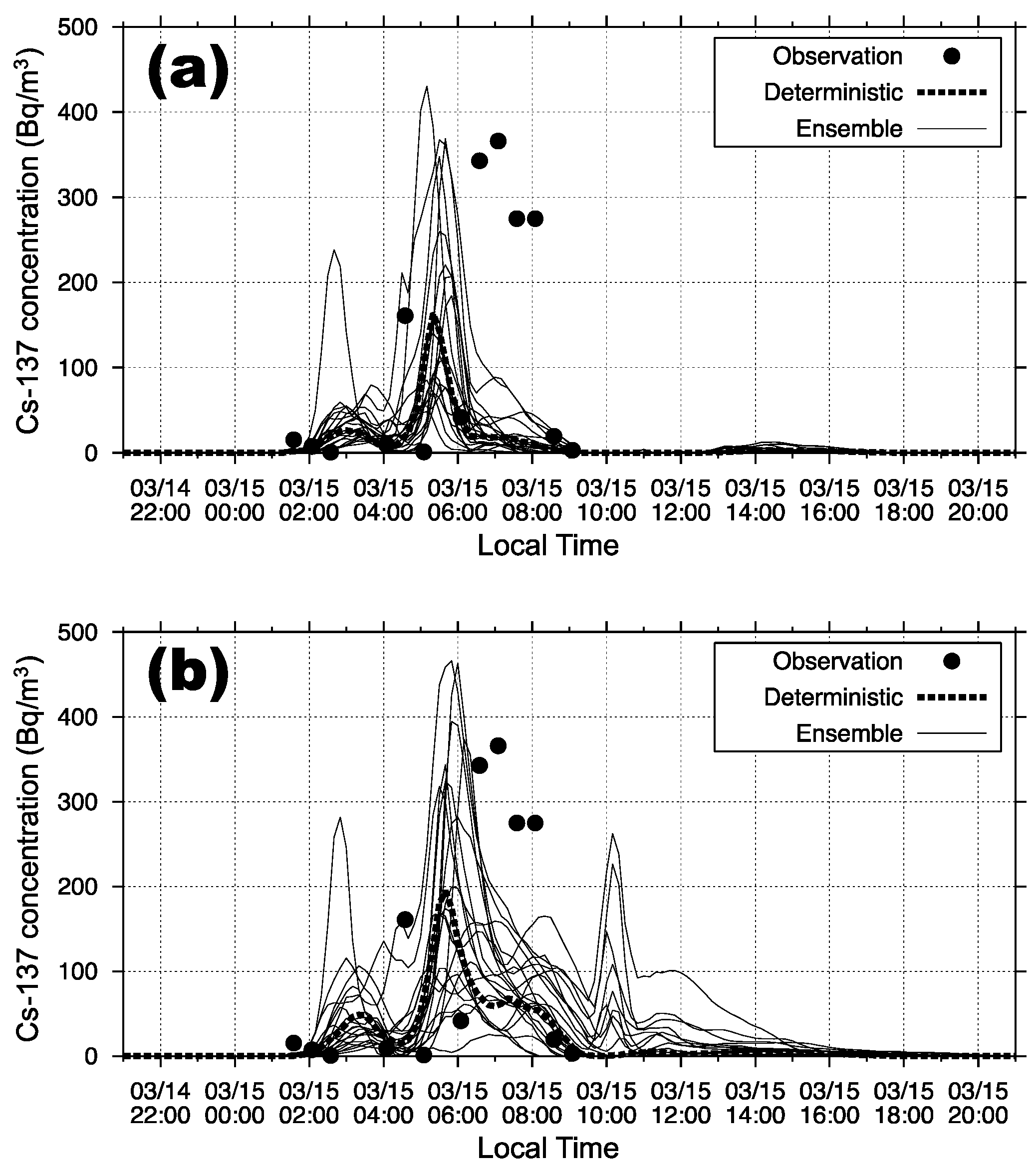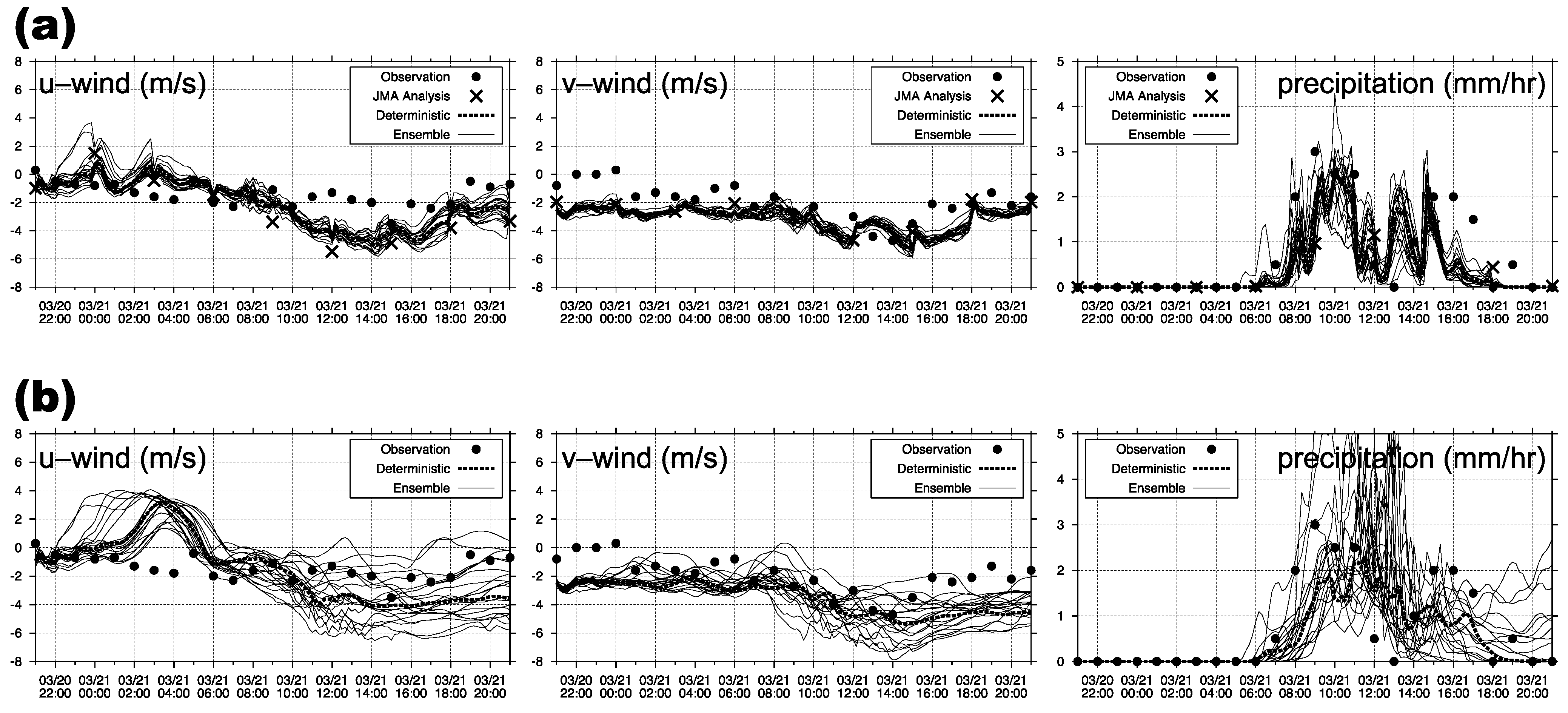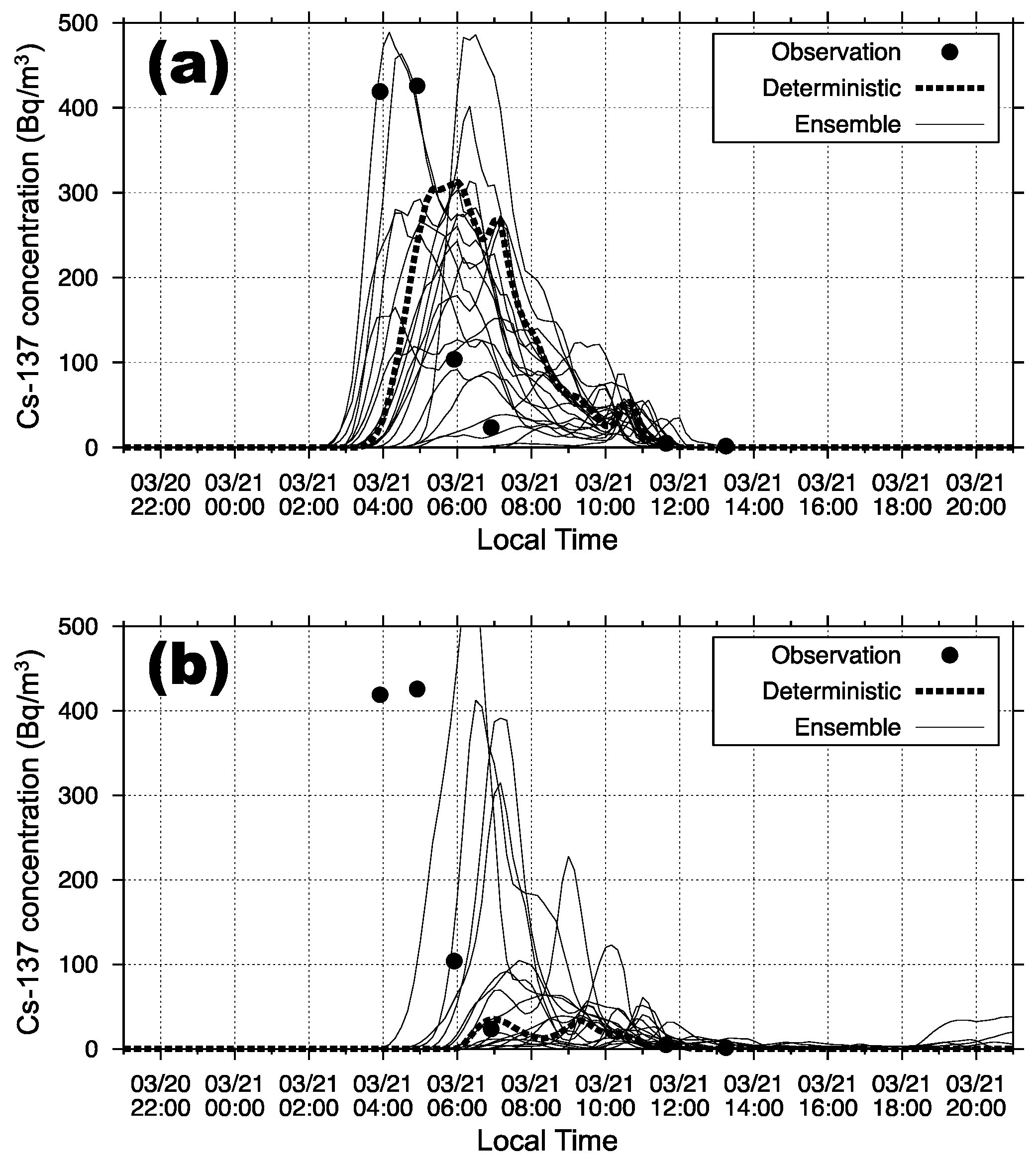Ensemble Dispersion Simulation of a Point-Source Radioactive Aerosol Using Perturbed Meteorological Fields over Eastern Japan
Abstract
:1. Introduction
2. Methodology
3. Results and Discussion
3.1. Period 1 (15 March 2011)
3.2. Period 2 (21 March 2011)
4. Conclusions
Author Contributions
Funding
Institutional Review Board Statement
Informed Consent Statement
Data Availability Statement
Acknowledgments
Conflicts of Interest
References
- Hoffman, R.N.; Kalnay, E. Lagged average forecasting, an alternative to Monte Carlo forecasting. Tellus A 1983, 35, 100–118. [Google Scholar] [CrossRef]
- Molteni, F.; Buizza, R.; Palmer, T.N.; Petroliagis, T. The new ECMWF ensemble prediction system: Methodology and validation. Q. J. R. Meteorol. Soc. 1996, 122, 73–119. [Google Scholar] [CrossRef]
- Houtekamer, P.L.; Mitchell, H.L.; Deng, X. Model Error Representation in an Operational Ensemble Kalman Filter. Mon. Weather Rev. 2009, 137, 2126–2143. [Google Scholar] [CrossRef]
- Galmarini, S.; Bianconi, R.; Klug, W.; Mikkelsen, T.; Addis, R.; Andronopoulos, S.; Astrup, P.; Baklanov, A.; Bartniki, J.; Bartzis, J.C.; et al. Ensemble dispersion forecasting, Part 1: Concept, Approach and indicators. Atmos. Environ. 2004, 38, 4607–4617. [Google Scholar] [CrossRef]
- Monache, L.D.; Deng, X.; Zhou, Y.; Stull, R. Ozone ensemble forecasts: 1. A new ensemble design. J. Geophys. Res. 2006, 111, D05307. [Google Scholar]
- Hegarty, J.; Draxler, R.R.; Stein, A.F.; Brioude, J.; Mountain, M.; Eluszkiewicz, J.; Nehrkorn, T.; Ngan, F.; Andrews, A. Evaluation of Lagrangian Particle Dispersion Models with Measurements from Controlled Tracer Releases. J. Appl. Meteorol. Clim. 2013, 52, 2623–2637. [Google Scholar] [CrossRef]
- Angevine, W.M.; Brioude, J.; McKeen, S.; Holloway, J.S. Uncertainty in Lagrangian pollutant transport simulations due to meteorological uncertainty from a mesoscale WRF ensemble. Geosci. Model Dev. 2014, 7, 2817–2829. [Google Scholar] [CrossRef] [Green Version]
- Draxler, R.; Arnold, D.; Chino, M.; Galmarini, S.; Hort, M.; Jones, A.; Leadbetter, S.; Malo, A.; Maurer, C.; Rolph, G.; et al. World Meteorological Organization’s model simulations of the radionuclide dispersion and deposition from the Fukushima Daiichi nuclear power plant accident. J. Environ. Radioact. 2015, 139, 172–184. [Google Scholar] [CrossRef] [PubMed]
- Dabberdt, W.F.; Miller, E. Uncertainty, ensembles and air quality dispersion modeling: Applications and challenges. Atmos. Environ. 2000, 34, 4667–4673. [Google Scholar] [CrossRef]
- Hanna, S.R.; Lu, Z.; Frey, H.C.; Wheeler, N.; Vukovich, J.; Arunachalam, S.; Femau, M.; Hansen, D.A. Uncertainties in predicted ozone concentrations due to input uncertainties for the UAM-V photochemical grid model applied to the July 1995 OTAG domain. Atmos. Environ. 2001, 35, 891–903. [Google Scholar] [CrossRef]
- Draxler, R.R. Evaluation of an Ensemble Dispersion Calculation. J. Appl. Meteorol. 2003, 42, 308–317. [Google Scholar] [CrossRef]
- Zhang, F.; Bei, N.; Nielsen-Gammon, J.W.; Li, G.; Zhang, R.; Stuart, A.; Aksoy, A. Impacts of meteorological uncertainties on ozone pollution predictability estimated through meteorological and photochemical ensemble forecasts. J. Geophys. Res. 2007, 112, D04304. [Google Scholar] [CrossRef]
- Holt, T.; Pullen, J.; Bishop, C.H. Urban and ocean ensembles for improved meteorological and dispersion modelling of the coastal zone. Tellus A 2009, 61, 232–249. [Google Scholar] [CrossRef]
- Lauvaux, T.; Pannekoucke, O.; Sarrat, C.; Chevallier, F.; Ciais, P.; Noilhan, J.; Rayner, P.J. Structure of the transport uncertainty in mesoscale inversions of CO2 sources and sinks using ensemble model simulations. Biogeosciences 2009, 6, 1089–1102. [Google Scholar] [CrossRef] [Green Version]
- Lattner, A.D.; Cervone, G. Ensemble modeling of transport and dispersion simulations guided by machine learning hypotheses generation. Comput. Geosci. 2012, 48, 267–279. [Google Scholar] [CrossRef]
- Haszpra, T.; Lagzi, I.; Tél, T. Dispersion of aerosol particles in the free atmosphere using ensemble forecasts. Nonlinear Process. Geophys. 2013, 20, 759–770. [Google Scholar] [CrossRef] [Green Version]
- Evensen, G. The Ensemble Kalman Filter: Theoretical formulation and practical implementation. Ocean Dyn. 2003, 53, 343–367. [Google Scholar] [CrossRef]
- Kalnay, E. Atmospheric Modeling, Data Assimilation and Predictability; Cambridge University Press: Cambridge, UK, 2003. [Google Scholar]
- Kalman, R.E. A New Approach to Linear Filtering and Prediction Problems. Trans. ASME J. Basic Eng. 1960, 82D, 35–45. [Google Scholar] [CrossRef] [Green Version]
- Wang, X.; Bishop, C.H.; Julier, S.J. Which Is Better, an Ensemble of Positive–Negative Pairs or a Centered Spherical Simplex Ensemble? Mon. Weather Rev. 2004, 132, 1590–1605. [Google Scholar] [CrossRef]
- Kunii, M. Mesoscale Data Assimilation for a Local Severe Rainfall Event with the NHM–LETKF System. Weather Forecast. 2014, 29, 1093–1105. [Google Scholar] [CrossRef]
- Hunt, B.R.; Kostelich, E.J.; Szunyogh, I. Efficient data assimilation for spatiotemporal chaos: A local ensemble transform Kalman filter. Phys. D 2007, 230, 112–126. [Google Scholar] [CrossRef] [Green Version]
- Saito, K.; Fujita, T.; Yamada, Y.; Ishida, J.; Kumagai, Y.; Aranami, K.; Ohmori, S.; Nagasawa, R.; Kumagai, S.; Muroi, C.; et al. The operational JMA nonhydrostatic mesoscale model. Mon. Weather Rev. 2006, 134, 1266–1298. [Google Scholar] [CrossRef]
- Saito, K.; Ishida, J.; Aranami, K.; Hara, T.; Segawa, T.; Narita, M.; Honda, Y. Nonhydrostatic atmospheric models operational development at JMA. J. Meteorol. Soc. Jpn. 2007, 85B, 271–304. [Google Scholar] [CrossRef] [Green Version]
- Miyoshi, T.; Aranami, K. Applying a four-dimensional local ensemble transform Kalman filter (4D-LETKF) to the JMA nonhydrostatic model (NHM). SOLA 2006, 2, 128–131. [Google Scholar] [CrossRef] [Green Version]
- Miyoshi, T.; Yamane, S. Local ensemble transform Kalman filtering with an AGCM at a T159/L48 resolution. Mon. Weather Rev. 2007, 135, 3841–3861. [Google Scholar] [CrossRef] [Green Version]
- Miyoshi, T. The Gaussian approach to adaptive covariance inflation and its implementation with the local ensemble transform Kalman filter. Mon. Weather Rev. 2011, 139, 1519–1535. [Google Scholar] [CrossRef]
- Miyoshi, T.; Kunii, M. The local ensemble transform Kalman filter with the Weather Research and Forecast Model: Experiments with real observations. Pure Appl. Geophys. 2012, 169, 321–333. [Google Scholar] [CrossRef]
- Kunii, M.; Miyoshi, T.; Kalnay, E. Estimating the impact of real observations in regional numerical weather prediction using an ensemble Kalman filter. Mon. Weather Rev. 2012, 140, 1975–1987. [Google Scholar] [CrossRef]
- Kunii, M.; Miyoshi, T. Including uncertainties of sea surface temperature in an ensemble Kalman filter: A case study of Typhoon Sinlaku (2008). Weather Forecast. 2012, 27, 1586–1597. [Google Scholar] [CrossRef]
- Miyazaki, K.; Eskes, H.J.; Sudo, K.; Takigawa, M.; van Weele, M.; Boersma, K.F. Simultaneous assimilation of satellite NO2, O3, CO, and HNO3 data for the analysis of tropospheric chemical composition and emissions. Atmos. Chem. Phys. 2012, 12, 9545–9579. [Google Scholar] [CrossRef] [Green Version]
- Nakamura, T.; Akiyoshi, H.; Deushi, M.; Miyazaki, K.; Kobayashi, C.; Shibata, K.; Iwasaki, T. A multimodel comparison of stratospheric ozone data assimilation based on an ensemble Kalman filter approach. J. Geophys. Res. Atmos. 2013, 118, 3848–3868. [Google Scholar] [CrossRef]
- Yumimoto, K.; Murakami, H.; Tanaka, T.Y.; Sekiyama, T.T.; Ogi, A.; Maki, T. Forecasting of Asian Dust Storm during 10-13 May in 2011 with an Ensemble-based Data Assimilation System. Particuology 2016, 28, 121–130. [Google Scholar] [CrossRef]
- Sekiyama, T.T.; Tanaka, T.Y.; Shimizu, A.; Miyoshi, T. Data assimilation of CALIPSO aerosol observations. Atmos. Chem. Phys. 2010, 10, 39–49. [Google Scholar] [CrossRef] [Green Version]
- Sekiyama, T.T.; Deushi, M.; Miyoshi, T. Operation-oriented ensemble data assimilation of total column ozone. SOLA 2011, 7, 41–44. [Google Scholar] [CrossRef] [Green Version]
- Sekiyama, T.T.; Tanaka, T.Y.; Maki, T.; Mikami, M. The effects of snow cover and soil moisture on Asian dust: II. Emission estimation by lidar data assimilation. SOLA 2011, 7A, 40–43. [Google Scholar] [CrossRef] [Green Version]
- Sekiyama, T.T.; Kunii, M.; Kajino, M.; Shimbori, T. Horizontal Resolution Dependence of Atmospheric Simulations of the Fukushima Nuclear Accident Using 15-km, 3-km, and 500-m Grid Models. J. Meteorol. Soc. Jpn 2015, 93, 45–60. [Google Scholar] [CrossRef] [Green Version]
- Sekiyama, T.T.; Yumimoto, K.; Tanaka, T.Y.; Nagao, T.; Kikuchi, M.; Murakami, H. Data Assimilation of Himawari-8 Aerosol Observations: Asian Dust Forecast in June 2015. SOLA 2016, 12, 86–90. [Google Scholar] [CrossRef] [Green Version]
- Sekiyama, T.T.; Kajino, M.; Kunii, M. The Impact of Surface Wind Data Assimilation on the Predictability of Near-Surface Plume Advection in the Case of the Fukushima Nuclear Accident. J. Meteorol. Soc. Jpn 2017, 95, 447–454. [Google Scholar] [CrossRef] [Green Version]
- Sekiyama, T.T.; Iwasaki, T. Mass flux analysis of 137Cs plumes emitted from the Fukushima Daiichi Nuclear Power Plant. Tellus B 2018, 70, 1–11. [Google Scholar] [CrossRef] [Green Version]
- Sekiyama, T.T.; Kajino, M. Reproducibility of Surface Wind and Tracer Transport Simulations over Complex Terrain Using 5-, 3-, and 1-km-Grid Models. J. Appl. Meteor. Climatol. 2020, 59, 937–952. [Google Scholar] [CrossRef] [Green Version]
- Nakanishi, M.; Niino, H. An improved Mellor-Yamada level 3 model with condensation physics: Its design and verification. Bound. Layer Meteorol. 2004, 112, 1–31. [Google Scholar] [CrossRef]
- Nakanishi, M.; Niino, H. An improved Mellor-Yamada level-3 model: Its numerical stability and application to a regional prediction of advection fog. Bound. Layer Meteorol. 2006, 119, 397–407. [Google Scholar] [CrossRef]
- Honda, Y.; Nishijima, M.; Koizumi, K.; Ohta, Y.; Tamiya, K.; Kawabata, T.; Tsuyuki, T. A pre-operational variational data assimilation system for a non-hydrostatic model at the Japan Meteorological Agency: Formulation and preliminary results. Q. J. R. Meteorol. Soc. 2005, 131, 3465–3475. [Google Scholar] [CrossRef]
- Adachi, K.; Kajino, M.; Zaizen, Y.; Igarashi, Y. Emission of spherical cesium-bearing particles from an early stage of the Fukushima nuclear accident. Sci. Rep. 2013, 3, 2554. [Google Scholar] [CrossRef] [Green Version]
- Kajino, M.; Inomata, Y.; Sato, K.; Ueda, H.; Han, Z.; An, J.; Katata, G.; Deushi, M.; Maki, T.; Oshima, N.; et al. Development of the RAQM2 aerosol chemical transport model and predictions of the Northeast Asian aerosol mass, size, chemistry, and mixing type. Atmos. Chem. Phys. 2012, 12, 11833–11856. [Google Scholar] [CrossRef] [Green Version]
- Kajino, M.; Sekiyama, T.T.; Mathieu, A.; Irène, K.; Périllat, R.; Quélo, D.; Quérel, A.; Saunier, O.; Adachi, K.; Girard, S.; et al. Lessons learned from atmospheric modeling studies after the Fukushima nuclear accident: Ensemble simulations, data assimilation, elemental process modeling, and inverse modeling. Geochem. J. 2018, 52, 85–101. [Google Scholar] [CrossRef] [Green Version]
- Kajino, M.; Deushi, M.; Sekiyama, T.T.; Oshima, N.; Yumimoto, K.; Tanaka, T.; Ching, J.; Hashimoto, A.; Yamamoto, Y.; Ikegami, M.; et al. NHM-Chem, the Japan Meteorological Agency’s Regional Meteorology-Chemistry Model: Model Evaluations toward the Consistent Predictions of the Chemical, Physical, and Optical Properties of Aerosols. J. Meteorolo. Soc. Jpn 2019, 97, 337–374. [Google Scholar] [CrossRef] [Green Version]
- Kajino, M.; Sekiyama, T.T.; Igarashi, Y.; Katata, G.; Sawada, M.; Adachi, K.; Zaizen, Y.; Tsuruta, H.; Nakajima, T. Deposition and dispersion of radio-cesium released due to the Fukushima nuclear accident: Sensitivity to meteorological models and physical modules. J. Geophys. Res. 2019, 124, 1823–1845. [Google Scholar] [CrossRef]
- Kajino, M.; Adachi, K.; Igarashi, Y.; Satou, Y.; Sawada, M.; Sekiyama, T.T.; Zaizen, Y.; Saya, A.; Tsuruta, H.; Moriguchi, Y. Deposition and Dispersion of Radio-Cesium Released Due to the Fukushima Nuclear Accident: 2. Sensitivity to Aerosol Microphysical Properties of Cs-bearing microparticles (CsMPs). J. Geophys. Res. 2021, 126, e2020JD033460. [Google Scholar] [CrossRef]
- Sato, Y.; Takigawa, M.; Sekiyama, T.T.; Kajino, M.; Terada, H.; Nagai, H.; Kondo, H.; Uchida, J.; Goto, D.; Quélo, D.; et al. Model intercomparison of atmospheric 137Cs from the Fukushima Daiichi Nuclear Power Plant accident: Simulations based on identical input data. J. Geophys. Res. 2018, 123, 11748–11765. [Google Scholar] [CrossRef] [Green Version]
- Sato, Y.; Sekiyama, T.T.; Fang, S.; Kajino, M.; Quérel, A.; Quélo, D.; Kondo, H.; Terada, H.; Kadowaki, M.; Takigawa, M.; et al. A model intercomparison of atmospheric 137Cs concentrations from the Fukushima Daiichi Nuclear Power Plant accident, Phase III: Simulation with an identical source term and meteorological field at 1-km resolution. Atmos. Environ. X 2020, 7, 100086. [Google Scholar] [CrossRef]
- Kitayama, K.; Morino, Y.; Takigawa, M.; Nakajima, T.; Hayami, H.; Nagai, H.; Terada, H.; Saito, K.; Shimbori, T.; Kajino, M.; et al. Atmospheric modeling of 137Cs plumes from the Fukushima Daiichi Nuclear Power Plant—Evaluation of the model intercomparison data of the Science Council of Japan. J. Geophys. Res. 2018, 123, 7754–7770. [Google Scholar]
- Iwasaki, T.; Sekiyama, T.T.; Nakajima, T.; Watanabe, A.; Suzuki, Y.; Kondo, H.; Morino, Y.; Terada, H.; Nagai, H.; Takigawa, M.; et al. Intercomparison of numerical atmospheric dispersion prediction models for emergency response to emissions of radionuclides with limited source information in the Fukushima Dai-ichi Nuclear Power Plant accident. Atmos. Environ. 2019, 214, 116830. [Google Scholar] [CrossRef]
- Chino, M.; Nakayama, H.; Nagai, H.; Terada, H.; Katata, G.; Yamazawa, H. Preliminary estimation of release amounts of 131I and 137Cs accidentally discharged from the Fukushima Daiichi Nuclear Power Plant into the atmosphere. J. Nucl. Sci. Technol. 2011, 48, 1129–1134. [Google Scholar] [CrossRef]
- Katata, G.; Ota, M.; Terada, H.; Chino, M.; Nagai, H. Atmospheric discharge and dispersion of radionuclides during the Fukushima Dai-ichi Nuclear Power Plant accident. Part I: Source term estimation and local-scale atmospheric dispersion in early phase of the accident. J. Environ. Radioact. 2012, 109, 103–113. [Google Scholar] [CrossRef] [Green Version]
- Terada, H.; Katata, G.; Chino, M.; Nagai, H. Atmospheric discharge and dispersion of radionuclides during the Fukushima Dai-ichi Nuclear Power Plant accident. Part II: Verification of the source term and analysis of regional-scale atmospheric dispersion. J. Environ. Radioact. 2012, 112, 141–154. [Google Scholar] [CrossRef] [PubMed] [Green Version]
- Kaneyasu, N.; Ohashi, H.; Suzuki, F.; Okuda, T.; Ikemori, F. Sulfate Aerosol as a Potential Transport Medium of Radiocesium from the Fukushima Nuclear Accident. Environ. Sci. Technol. 2012, 46, 5720–5726. [Google Scholar] [CrossRef]
- Katata, G.; Chino, M.; Kobayashi, T.; Terada, H.; Ota, M.; Nagai, H.; Kajino, M.; Draxler, R.; Hort, M.C.; Malo, A.; et al. Detailed source term estimation of the atmospheric release for the Fukushima Daiichi Nuclear Power Station accident by coupling simulations of an atmospheric dispersion model with an improved deposition scheme and oceanic dispersion model. Atmos. Chem. Phys. 2015, 15, 1029–1070. [Google Scholar] [CrossRef] [Green Version]
- Nakajima, T.; Misawa, S.; Morino, Y.; Tsuruta, H.; Goto, D.; Uchida, J.; Takemura, T.; Ohara, T.; Oura, Y.; Ebihara, M.; et al. Model depiction of the atmospheric flows of radioactive cesium emitted from the Fukushima Daiichi Nuclear Power Station accident. Prog. Earth Planet. Sci. 2017, 4, 2. [Google Scholar] [CrossRef] [Green Version]
- Ohkura, T.; Oishi, T.; Taki, M.; Shibanuma, Y.; Kikuchi, M.; Akino, H.; Kikuta, Y.; Kawasaki, M.; Saegusa, J.; Tsutsumi, M.; et al. Emergency Monitoring of Environmental Radiation and Atmospheric Radionuclides at Nuclear Science Research Institute, JAEA following the Accident of Fukushima Daiichi Nuclear Power Plant, JAEA-Data/Code 2012-010; Japan Atomic Energy Agency: Tokai, Japan, 2012.
- Makihara, Y.; Uekiyo, N.; Tabata, A.; Abe, Y. Accuracy of Radar-AMeDAS Precipitation. IEICE Trans. Commun. 1996, 79, 751–762. [Google Scholar]








| 2:00–8:00 15 March | 4:00–10:00 21 March | |||
|---|---|---|---|---|
| Analysis | Forecast | Analysis | Forecast | |
| Wind speed | 5% | 7% | 10% | 23% |
| Cs-137 concentration | 93% | 82% | 77% | 235% |
Publisher’s Note: MDPI stays neutral with regard to jurisdictional claims in published maps and institutional affiliations. |
© 2021 by the authors. Licensee MDPI, Basel, Switzerland. This article is an open access article distributed under the terms and conditions of the Creative Commons Attribution (CC BY) license (https://creativecommons.org/licenses/by/4.0/).
Share and Cite
Sekiyama, T.T.; Kajino, M.; Kunii, M. Ensemble Dispersion Simulation of a Point-Source Radioactive Aerosol Using Perturbed Meteorological Fields over Eastern Japan. Atmosphere 2021, 12, 662. https://doi.org/10.3390/atmos12060662
Sekiyama TT, Kajino M, Kunii M. Ensemble Dispersion Simulation of a Point-Source Radioactive Aerosol Using Perturbed Meteorological Fields over Eastern Japan. Atmosphere. 2021; 12(6):662. https://doi.org/10.3390/atmos12060662
Chicago/Turabian StyleSekiyama, Tsuyoshi Thomas, Mizuo Kajino, and Masaru Kunii. 2021. "Ensemble Dispersion Simulation of a Point-Source Radioactive Aerosol Using Perturbed Meteorological Fields over Eastern Japan" Atmosphere 12, no. 6: 662. https://doi.org/10.3390/atmos12060662
APA StyleSekiyama, T. T., Kajino, M., & Kunii, M. (2021). Ensemble Dispersion Simulation of a Point-Source Radioactive Aerosol Using Perturbed Meteorological Fields over Eastern Japan. Atmosphere, 12(6), 662. https://doi.org/10.3390/atmos12060662







